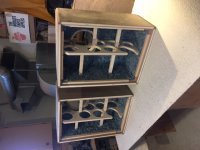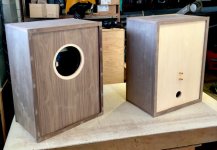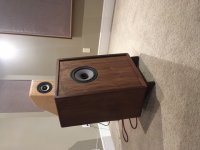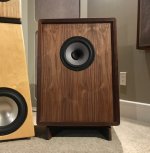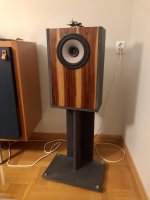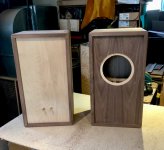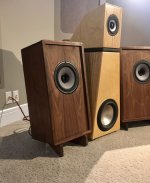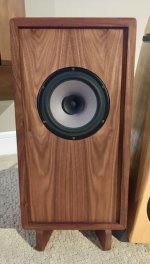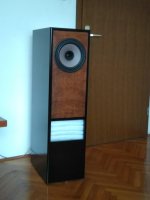I have been enjoying these for the last few weeks now and I'm very impressed! I used the plans Scottmoose released for a large vented cabinet for the FA22RCZ. I used walnut ply for the sides and Baltic birch for the front and rear baffles (front has walnut veneer). The bracing was not in the plans but was recommended. I did use a 1.5mH inductor in series with a 15 Ohm resistor (as per the Seas application note) to tame the HF but with this small change I find these hard to beat! They are one my favorite builds to date! Thanks to the exceptional cabinet design and Scott for posting it!
Attachments
Congratulations, it looks really good. Your box is quite wide, pushing baffle step toward 200 hz I guess. I assume that it produces that midbass "push/thump", which slim modern speakers just cannot match.
My favourite DIY is also a SEAS FA22RCZ, playing on it just now. I have, however, chosen a sealed enclosure, also quite wide (36 cm). I use a MiniDSP to linearize the frequency and boost the bass a bit. It both measures well, and has a nice sound stage.
My favourite DIY is also a SEAS FA22RCZ, playing on it just now. I have, however, chosen a sealed enclosure, also quite wide (36 cm). I use a MiniDSP to linearize the frequency and boost the bass a bit. It both measures well, and has a nice sound stage.
Attachments
Last edited:
I find adding supertweeter helps in providing sparkle to the sound. Try a small tweeter maybe a 1/2inch with a 1 or 2 uF capacitor in series. I found it helps a lot.
Oon
Oon
I have had some time to play around and actually built a smaller sealed version of the same cabinet... For smaller rooms I prefer the sealed version with its super fast and tight bass, even if it doesnt dig quite as low as its bigger brother... I can get similar results by stuffing the ports in the bigger version when moved to smaller rooms but they do have a much bigger foot print...
Attachments
Great work "11-opas". I agree that the sealed-bass is faster, and I like it better. It can, however, be further improved.
I am therefore currently starting to build a bass for my fullrange. It is inspired by the Dutch & Dutch 8C, Allison effect.
- Rear firing 8" sealed, 10 cm from front wall
- Each bass is placed behind each Seas FR
- Delay the front firing Seas FR accordingly
- XO 200 hz LR 48 db
- Using a FIR to linearize the filter, no group-delay or phase rotation
- Separate amplifiers for bass, Hypex class D
- Implemented in the Minidsp 2x4HD
I have already prototyped an impementation, and it measures good. It improves directivity up to 250 hz, and removes the typical front-wall cancellations in the 100-200 hz range.
I am therefore currently starting to build a bass for my fullrange. It is inspired by the Dutch & Dutch 8C, Allison effect.
- Rear firing 8" sealed, 10 cm from front wall
- Each bass is placed behind each Seas FR
- Delay the front firing Seas FR accordingly
- XO 200 hz LR 48 db
- Using a FIR to linearize the filter, no group-delay or phase rotation
- Separate amplifiers for bass, Hypex class D
- Implemented in the Minidsp 2x4HD
I have already prototyped an impementation, and it measures good. It improves directivity up to 250 hz, and removes the typical front-wall cancellations in the 100-200 hz range.
Last edited:
11opas,
What are the dimensions of the ported box you have there (post #1), especially the port ?
Fern & Roby Raven ported is...………………...
"Overall dimensions (assembled):
The Ravens are 19.25 wide and 30.5" at their tallest off the floor. The base is about 6.25" tall at the front with an 8 degree pitch to angle the speakers into the correct listening position.
Enclosure Dimensions:
19.25" wide x 24.5" tall x 11.5" deep
When the Ravens ship to our clientele, the base is unbolted and packaged separately to protect them in transit.
Weight: 75 pounds each"
The Ravens |
Fern & Roby
What are the dimensions of the ported box you have there (post #1), especially the port ?
Fern & Roby Raven ported is...………………...
"Overall dimensions (assembled):
The Ravens are 19.25 wide and 30.5" at their tallest off the floor. The base is about 6.25" tall at the front with an 8 degree pitch to angle the speakers into the correct listening position.
Enclosure Dimensions:
19.25" wide x 24.5" tall x 11.5" deep
When the Ravens ship to our clientele, the base is unbolted and packaged separately to protect them in transit.
Weight: 75 pounds each"
The Ravens |
Fern & Roby
The design is very similar to the Fern and Roby Raven cabinet. I do enjoy the mid century modern look it has. The Ravens retail for around $11000 USD...😱
Im not sure why its not showing up but the cabinet plans for the speaker are on the first page, second post of Miscellaneous designs- Diy Audio...
Im not sure why its not showing up but the cabinet plans for the speaker are on the first page, second post of Miscellaneous designs- Diy Audio...
Direct link: https://www.diyaudio.com/forums/ful...io-fostex-tb-dayton-seas-etc.html#post5442144
Im not sure why its not showing up but the cabinet plans for the speaker are on the first page, second post of Miscellaneous designs- Diy Audio...
Likely your browser, emoty the cache.
Here the plan from Scott’s thread:
And the copy tou reattached a few posts ago:
dave
- Home
- Loudspeakers
- Full Range
- SEAS FA22RCZ build
